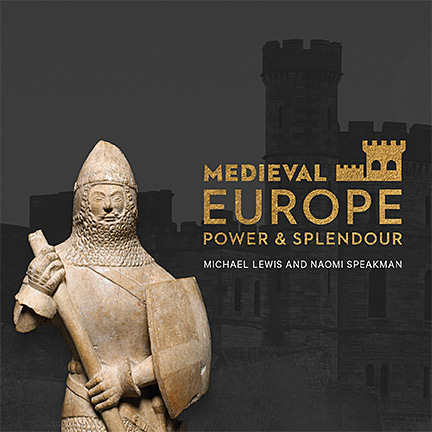Step into a world of legend. Medieval tales of knights and chivalry still thrill us today. From the fall of Rome to the birth of the Renaissance, the medieval era transformed Europe. Innovations, from the Magna Carta to the founding of universities, continue to shape our modern world. Over 200 treasures from the world-renowned British Museum, many never before seen in North America, conjure a world of deadly power struggles and spectacular romance.
An exhibition developed by the British Museum in collaboration with the Canadian Museum of History.
Photo: Figurine of a Knight, England, 1375–1425, stone. © The Trustees of the British Museum. All rights reserved.
The Exhibition in Pictures
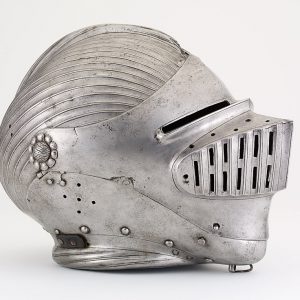 Armet HelmetThis type of helmet was most popular between 1475 and 1525, when plate armour was at its height. It completely enclosed the head, and its grilled visor gave the wearer a balance between vision and protection. It was used exclusively by knights wearing full suits of armour. By the end of the Middle Ages, the use of guns and cannons made wearing plate armour for protection useless.
Armet HelmetThis type of helmet was most popular between 1475 and 1525, when plate armour was at its height. It completely enclosed the head, and its grilled visor gave the wearer a balance between vision and protection. It was used exclusively by knights wearing full suits of armour. By the end of the Middle Ages, the use of guns and cannons made wearing plate armour for protection useless.
1500–1525
Austria
Steel
1881,0802.28
Photo: © The Trustees of the British Museum. All rights reserved.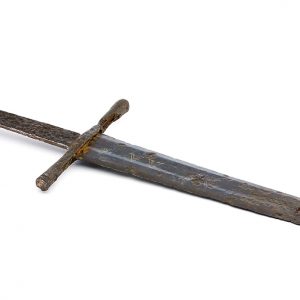 SwordThis fragment was originally part of a long sword, which was designed to be used on horseback, the momentum of the charge enabling the rider to deliver a stronger blow. Inlaid with copper alloy, the blade is engraved on one side with a heart and the letters VV; the other depicting a running animal, possibly a wolf.
SwordThis fragment was originally part of a long sword, which was designed to be used on horseback, the momentum of the charge enabling the rider to deliver a stronger blow. Inlaid with copper alloy, the blade is engraved on one side with a heart and the letters VV; the other depicting a running animal, possibly a wolf.
1400–1500
England
Iron
1881,0802.127
Photo: © The Trustees of the British Museum. All rights reserved.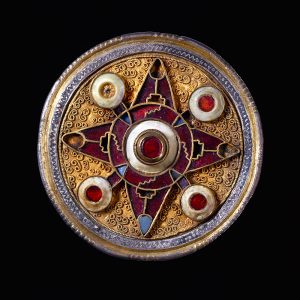 The Wingham BroochThis intricate brooch is of a type popular during the 500s and early 600s in Kent, an Anglo-Saxon kingdom in present-day South East England. Kent forged healthy trade and diplomatic contacts with Frankia (centring on modern-day France and parts of Germany). This brooch is a testament to the kingdom’s increasing wealth and status.
The Wingham BroochThis intricate brooch is of a type popular during the 500s and early 600s in Kent, an Anglo-Saxon kingdom in present-day South East England. Kent forged healthy trade and diplomatic contacts with Frankia (centring on modern-day France and parts of Germany). This brooch is a testament to the kingdom’s increasing wealth and status.
575–625
England
Gilded silver, garnet, blue glass, shell
1879,0524.34
Photo: © The Trustees of the British Museum. All rights reserved.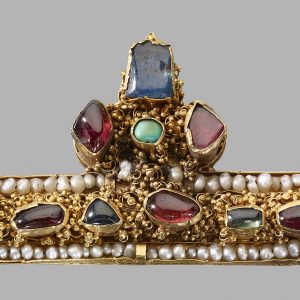 Crown FragmentFew medieval crowns survive today, as most were destroyed or refashioned. This delicate fragment comes from a crown that would probably have been worn by a woman. The range of precious gemstones, sourced by merchants trading beyond Europe, reveal the splendour in which monarchs lived.
Crown FragmentFew medieval crowns survive today, as most were destroyed or refashioned. This delicate fragment comes from a crown that would probably have been worn by a woman. The range of precious gemstones, sourced by merchants trading beyond Europe, reveal the splendour in which monarchs lived.
1250–1300
Hungary or France
Gold, sapphire, ruby, emerald, seed pearl
AF.2681
Photo: © The Trustees of the British Museum. All rights reserved.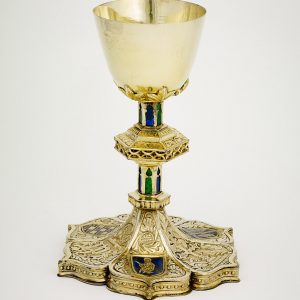 ChaliceThis chalice was said to have been given by Count de Velasco (1425–1492) to a religious hospital in Spain. Although the blessed wine held in such vessels was shared, the moment of its consecration was concealed from worshippers by a wooden screen, imbuing a sense of the miraculous.
ChaliceThis chalice was said to have been given by Count de Velasco (1425–1492) to a religious hospital in Spain. Although the blessed wine held in such vessels was shared, the moment of its consecration was concealed from worshippers by a wooden screen, imbuing a sense of the miraculous.
1450–1500
Spain
Gilded silver, enamel
1911,0621.6
Photo: © The Trustees of the British Museum. All rights reserved.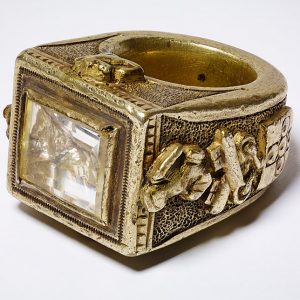 Papal RingThis ring is associated with Pope Pius II (r. 1458–1464), who would also have had representatives in the royal courts. It bears the arms of his family (Piccolomini), with the keys of the Holy See, and the inscription PAPA PIO (“Pope Pius”). The size of the ring and the prominent display of the insignia suggest it may have been worn on the gloved hand of a papal representative.
Papal RingThis ring is associated with Pope Pius II (r. 1458–1464), who would also have had representatives in the royal courts. It bears the arms of his family (Piccolomini), with the keys of the Holy See, and the inscription PAPA PIO (“Pope Pius”). The size of the ring and the prominent display of the insignia suggest it may have been worn on the gloved hand of a papal representative.
1458–1464
Italy
Gilded copper alloy, glass
1888,1201.9
Photo: © The Trustees of the British Museum. All rights reserved.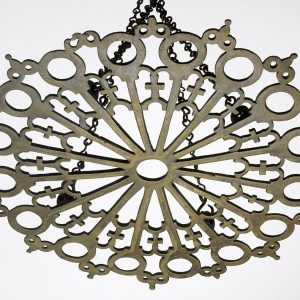 PolycandelonLight was used throughout churches: sunlight flowed through coloured stained-glass windows and lamps and candles burned. Many churches close to the Mediterranean were adorned with light-creating objects, such as this polycandelon, which held oil-filled glass vessels in its round openings.
PolycandelonLight was used throughout churches: sunlight flowed through coloured stained-glass windows and lamps and candles burned. Many churches close to the Mediterranean were adorned with light-creating objects, such as this polycandelon, which held oil-filled glass vessels in its round openings.
400–700
Byzantine Empire (now Turkey)
Copper alloy
1868,0120.1
Photo: © The Trustees of the British Museum. All rights reserved.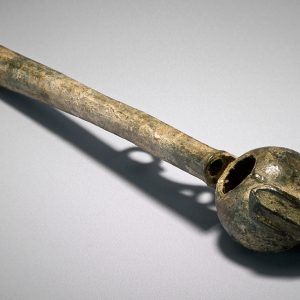 Falcon WhistleBirds of prey were favourite pets of the wealthy. Contemporary books advised which breeds could be owned by different levels of the nobility. This whistle would have been used to control the movements of the bird when hunting, and to call it back from long distances. It is believed that Henry VIII gave Anne Boleyn a gold whistle pendant as a love gift.
Falcon WhistleBirds of prey were favourite pets of the wealthy. Contemporary books advised which breeds could be owned by different levels of the nobility. This whistle would have been used to control the movements of the bird when hunting, and to call it back from long distances. It is believed that Henry VIII gave Anne Boleyn a gold whistle pendant as a love gift.
1500–1600
England
Copper alloy
OA.7300
Photo: © The Trustees of the British Museum. All rights reserved.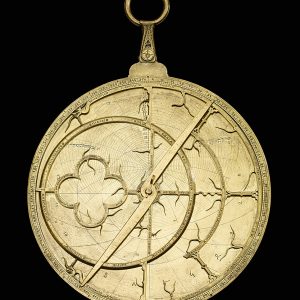 AstrolabePerfected in the Middle Ages by Muslim scholars, the astrolabe spread across the courts of Europe. It was designed to tell the time during the day and the night, and had a star map to aid surveying and astronomy. This example is inscribed in Latin with the name of the English maker, BLAKENE. Beautiful and useful, astrolabes are often listed in the possessions of princes and courtiers.
AstrolabePerfected in the Middle Ages by Muslim scholars, the astrolabe spread across the courts of Europe. It was designed to tell the time during the day and the night, and had a star map to aid surveying and astronomy. This example is inscribed in Latin with the name of the English maker, BLAKENE. Beautiful and useful, astrolabes are often listed in the possessions of princes and courtiers.
1342
England
Copper alloy
1853,1104.1
Photo: © The Trustees of the British Museum. All rights reserved.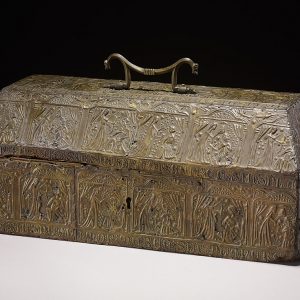 Casket with Romantic ScenesCovered with typical scenes of medieval courtship, this casket shows rows of couples in curtain-framed compartments in different romantic poses. The romantic imagery and size of this casket suggest that it would have been used to carry the valuables of a woman.
Casket with Romantic ScenesCovered with typical scenes of medieval courtship, this casket shows rows of couples in curtain-framed compartments in different romantic poses. The romantic imagery and size of this casket suggest that it would have been used to carry the valuables of a woman.
1450–1530
Southern France or Spain
Wood, embossed copper alloy
1891,0116.1
Photo: © The Trustees of the British Museum. All rights reserved.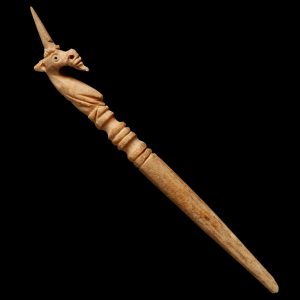 Pin with a UnicornCarved in bone, this pin terminates in the delicate head of a unicorn, a symbol of grace. Contemporary writers described how unicorns, because of their purity, could only be captured or tamed by a virgin maiden. The wearing of this miniature unicorn by a woman was perhaps a public statement on her virtue.
Pin with a UnicornCarved in bone, this pin terminates in the delicate head of a unicorn, a symbol of grace. Contemporary writers described how unicorns, because of their purity, could only be captured or tamed by a virgin maiden. The wearing of this miniature unicorn by a woman was perhaps a public statement on her virtue.
1500–1600
England
Bone
1932,0307.5
Photo: © The Trustees of the British Museum. All rights reserved.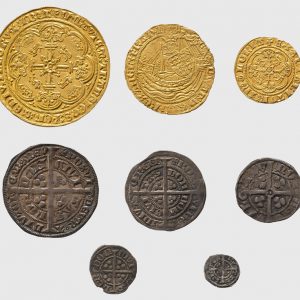 Eight Coins1 [206] Gold noble of Edward III, 1327–1377
Eight Coins1 [206] Gold noble of Edward III, 1327–1377
2 [207] Gold half noble of Edward III, 1327–1377
3 [208] Gold quarter noble of Edward III, 1327–1377
4 [209] Silver groat of Edward III, 1356–1361
5 [210] Silver half groat of Edward III, 1351–1352
6 [211] Silver penny of Edward III, 1327–1377
7 [212] Silver halfpenny of Edward III, 1361–1369
8 [213] Silver farthing of Edward III, 1369–1377
All dating from the reign of King Edward III, these coins show the range of denominations used in England during the 1300s. Used for day-to-day transactions, an established coinage created economic stability. These coins bear Edward’s image and name. During his reign, Edward III used steady taxation to fund wars with France, for which large quantities of new coins were needed.
1300s
England (206, 208–213), France (207)
Gold and silver
E.4357; 1920,0816.11; 1935,0401.2600; 1915,0507.1894; 1935,1117.911; 1924,0507.34; 2003,1201.372; 2003,1201.387
Photo: © The Trustees of the British Museum. All rights reserved.
Mark your calendar
Get Your Souvenir Catalogue
Complete your visit by picking up the Medieval Europe souvenir catalogue, on sale online and at the Museum Gift Shop.

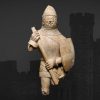
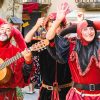 Activity
Activity
 Activity
Activity
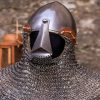 Activity
Activity
